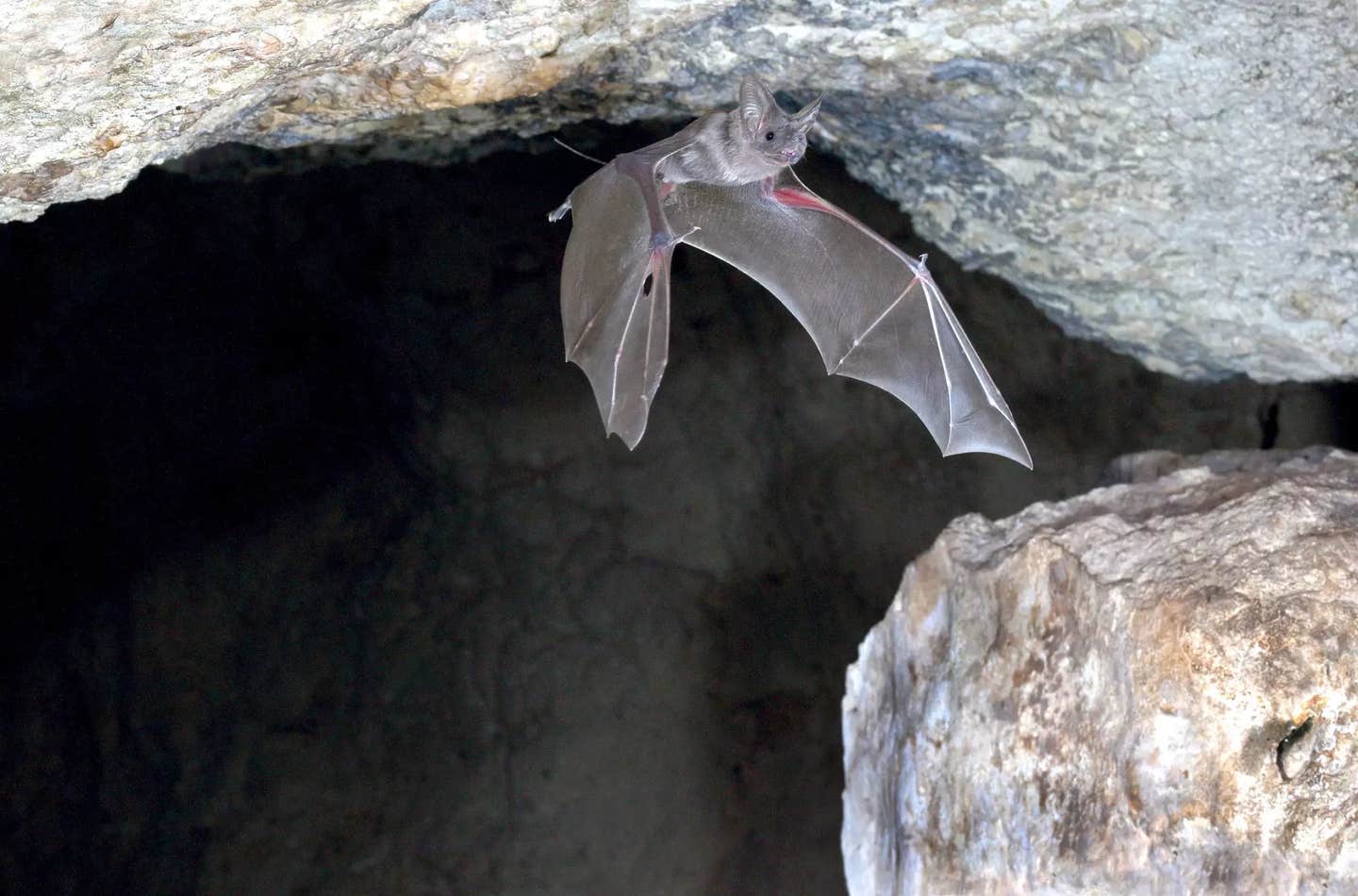Scientists solve the mystery of bat echolocation
Bats dodge each other midair despite mass echolocation jamming. Here’s how they do it with near-perfect precision.

Greater mouse-tailed bat (Rhinopoma microphyllum). (CREDIT: Jens Rydell)
As darkness falls and the air begins to cool, thousands of bats burst from the narrow mouth of their cave. The sky comes alive with their flapping wings, filling the air like a living liquid. It's a nightly ritual that repeats across the globe. But amid this aerial rush, something astonishing happens: they don’t crash into each other. Despite emerging in tight formations, collisions are rare. That mystery has puzzled scientists for decades.
Echolocating animals like bats navigate by bouncing sound off objects and listening for the echoes. The greater mouse-tailed bat, for instance, sends out ultrasonic calls and reads the returning sound to “see” the world. But what happens when thousands echolocate at once? Shouldn’t the soundscape become too chaotic to process? Wouldn’t the bats become deafened by one another’s calls, crashing midair in a biological traffic jam?
Until now, the answer to that question has remained elusive. Past studies explored how small groups of bats might avoid “jamming”—the loss of vital sound information when many calls interfere.
Researchers in controlled lab settings found that some bats adjusted their frequency or timing to avoid overlap. Others appeared to use memory or ear movements to sort useful echoes from noise. But these strategies didn’t explain what happens in the wild, when bat densities reach levels far beyond what labs could replicate.
That’s why a recent study led by researchers from Tel Aviv University, in collaboration with the Max Planck Institute of Animal Behavior, broke new ground. They stepped into the bats’ world during one of the most acoustically challenging moments of their lives—the collective emergence from a cave.
Listening in on the swarm
To do this, scientists tracked greater mouse-tailed bats flying through Israel’s Hula Valley. Each year, the animals emerge from a single cave in massive numbers. Over two years, researchers fitted dozens of bats with lightweight devices that recorded their location once per second. Some trackers also had ultrasonic microphones to capture what the bat was hearing in real time.
“Even though we’ve watched this emergence many times,” said researcher Aya Goldshtein, “we’re still amazed every time. These bats fly out by the thousands, shoulder-to-shoulder, and they never seem to crash.”
Related Stories
To complete the picture, scientists used a computational model to simulate what happens right at the cave’s mouth—an area too dense to record directly. The model used real field data from the tagged bats and recreated the path bats take in their first two kilometers after exiting.
According to Omer Mazar, who developed the simulation, “The model helps us test our ideas about how bats manage such a complex task in such a short time.”
The combined data set provided a new way of looking at the problem—from the perspective of an individual bat surrounded by thousands of others, all echolocating at once.
A sonic overload at takeoff
The findings, published in the journal PNAS Ecology, were striking. At the cave’s exit, an individual bat hears an almost deafening chorus. The data showed that about 94 percent of echoes were jammed—meaning nearly all the returning sound cues were masked by others' calls.
Yet the bats still manage to fly.
How? The key lies in how they behave once they clear the opening. Within just five seconds, bats begin to space themselves out while still remaining part of the swarm. As they fan out, the level of acoustic jamming drops quickly. They also start to adjust the way they echolocate.
Instead of blasting long, loud calls into the sky, they shorten them. They also raise the frequency. These changes result in weaker calls that are less likely to overlap with those of nearby bats.
At first glance, this adjustment seems puzzling. Wouldn’t higher-frequency calls, which don’t travel as far, reduce the bat’s ability to detect obstacles? And wouldn’t more calls make jamming worse?
Not exactly, said Mazar. “What matters most is not detecting everything. What matters is detecting the bat directly in front of you. That’s the one you’ll collide with if you’re not careful. So you change your echolocation in a way that gives you the best detail about that one neighbor, even if everything else becomes noise.”
In other words, bats aren’t trying to avoid all jamming. They’re tuning their sensory system to pick up just enough detail to dodge others. That level of information is all they need to avoid crashing.
Dodging danger without jamming avoidance
This insight challenges earlier assumptions about how bats avoid signal overlap. For years, scientists believed bats must rely on a "jamming avoidance response"—a behavior where they shift frequency or timing to avoid overlapping signals. This idea worked well in labs where only a few bats were studied at a time. But the new study shows that in the real world, bats don’t seem to rely on such strategies during mass emergence.
Instead, they accept that some jamming will occur, and they use redundancy and close-range focus to stay safe. Their brains seem wired to pick out useful bits from the acoustic chaos and act on them fast.
These findings also highlight how animals handle sensory interference during collective movement—a challenge that isn’t unique to bats. Many species, from birds to fish to humans in crowds, need to balance group cohesion with avoiding collisions. Most studies have focused on how these animals use vision or passive hearing. But few have explored how they handle sensory overload.
That makes bats a fascinating model. Unlike birds or fish, which mostly rely on sight or lateral line sensing, bats use active sensing—they emit energy into the world and read the feedback. That energy can interfere when many individuals are doing the same thing in a small space. And yet, they still navigate with near-perfect precision.
A new view of collective movement
The key takeaway from the study is that animals don’t always need perfect information to move as a group. They just need enough. And by tuning their sensory systems for close-range detection and quickly dispersing from high-density areas, bats solve the “cocktail party nightmare” of signal jamming in a surprisingly simple way.
“You’re almost excited when you witness a bat collision,” said Goldshtein. “That’s how rare they are.”
This kind of work opens new doors for how scientists think about collective behavior. It suggests that success in noisy environments doesn’t come from avoiding noise altogether but from learning to focus through it.
The results also show the value of studying animals in their natural settings. Past lab studies laid the foundation, but it took field research—where the real action happens—to uncover the bats’ strategy.
As Goldshtein puts it, “Theoretical and lab studies allowed us to imagine the possibilities. But only by stepping into the animal’s world can we understand the real challenges they face.”
Note: The article above provided above by The Brighter Side of News.
Like these kind of feel good stories? Get The Brighter Side of News' newsletter.
Rebecca Shavit
Science & Technology Journalist | Innovation Storyteller
Based in Los Angeles, Rebecca Shavit is a dedicated science and technology journalist who writes for The Brighter Side of News, an online publication committed to highlighting positive and transformative stories from around the world. With a passion for uncovering groundbreaking discoveries and innovations, she brings to light the scientific advancements shaping a better future. Her reporting spans a wide range of topics, from cutting-edge medical breakthroughs and artificial intelligence to green technology and space exploration. With a keen ability to translate complex concepts into engaging and accessible stories, she makes science and innovation relatable to a broad audience.



